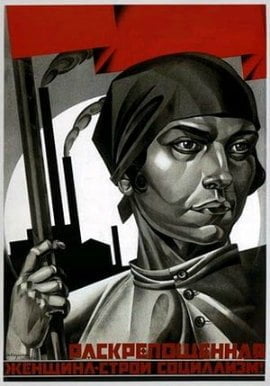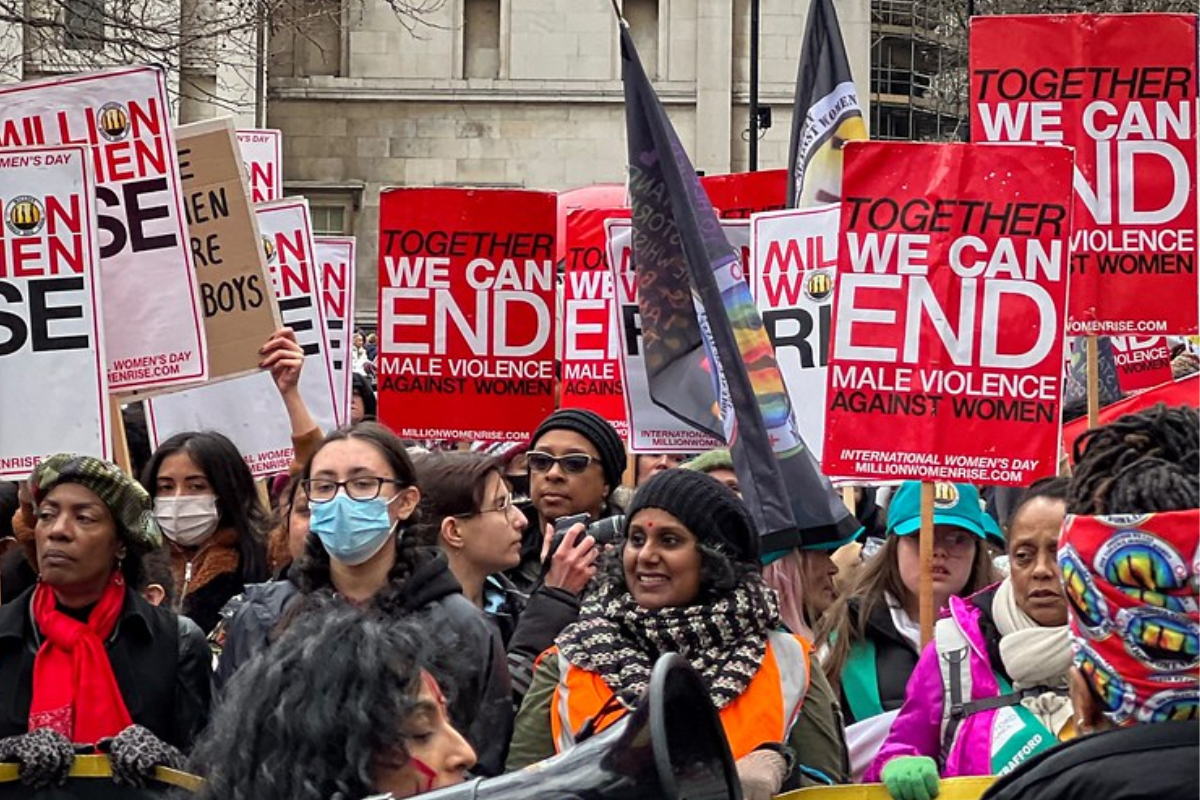The apologists of capitalism use 8th March, International Women’s Day, as a time to give their annual vague reminder about the need to ‘address’ gender inequality worldwide. Jo Pickard, President of the Sussex Marxist Society, asks: regardless of the number of power-dressing female CEOs gracing the boardrooms of capitalism, what tangible gains have actually been felt by working women internationally?
The apologists of capitalism use 8th March, International Women’s Day, as a time to give their annual vague reminder about the need to ‘address’ gender inequality worldwide. Regardless of the number of power-dressing female CEOs gracing the boardrooms of capitalism, what tangible gains have actually been felt by working women internationally?
Despite amounting to over half of the world’s global population, and equating to 40% of the labour force, women workers control virtually none of the world’s resources. Even among the capitalist class, the reality is that only 1% of global capital is possessed by women. Among the advanced capitalist countries, the average wage for a woman is 22% less than for her male colleagues. In the epoch of capitalist crisis – bringing with it the casualisation of labour and an epidemic of zero-hour contracts – wage disparity between male and female workers is still growing.
In periods of growth capitalism can grant certain concessions to workers as a by-product of their industrial and political struggles. Women workers in advanced capitalist countries in particular have struggled to end sex discrimination and close the pay gap, with partial success. Inevitably, however, during periods of economic stagnation, the ruling class are forced to take back any meagre concessions they have been able to grant.
Impact of austerity
The responsibilities of the family are beginning to bear more heavily on the shoulders of women. Cuts to welfare provision and care for the elderly; rising child-care costs, and increasing food prices are all steadily adding to the list of concerns for the female worker.
One in five mothers in the UK sacrifices a meal each day to feed their children. Access to family planning and the rights of women to control their own fertility are also gains which are falling by the wayside as public sector cuts cause family planning clinics, drop-in clinics and local health centres to be closed. In many countries where economic crisis is being expressed through political crisis, right-wing politicians are actively challenging the fertility rights of women. The introduction of more restrictive laws on abortion in Spain, and regressive threats concerning child sex education in UK schools, are just two examples.
The historic and vilest forms of women’s oppression are returning even to the ‘civilised liberal democracies’ of the West. In order to decrease labour costs, women in particular are becoming casualised labour. In the UK, 43% of female workers are in part-time employment compared to 13% of employed men (Office of National Statistics, 2012). Almost 70% of employers consider women of childbearing age to be ‘less attractive to recruit’ on account of maternity rights.
The worldwide position of women workers
The need to cut labour costs drives capitalists to countries where the gains of trade unionism and workers struggle are not as great. The conditions for women in these countries are even worse.
In China, with a national capitalist class notorious for its unashamed hyper-exploitation of the working class, Pegatron factories, which produce parts for Apple products, have been reported working pregnant women 11 hours per day in order to drive women out of the workplace for ‘out of wedlock’ pregnancy, and regularly harass female workers. In Guangzhou province, almost 70% of female factory workers have experienced sexual harassment. Similar conditions can be seen elsewhere. Rape and sexual assault is rife in India, with every woman expected to experience some form of harassment at least once in her lifetime.
In Bangladesh, the tragic collapse of the garment factories producing clothing for Western high-street retailers Zara, GAP, Walmart and H&M, has brought to light the repulsive conditions of women labourers there. Not only is health and safety a minimal priority – evident from the building collapses – but the extent of the consistent maltreatment of the workers themselves is only now being reported.
If the women in these factories ever failed to meet production targets they were kicked and slapped. Air ventilation in the factories was so poor that women regularly fainted, and access to toilet facilities was rarely granted. This abhorrent disrespect for women is not a cultural phenomenon of China or the Indian subcontinent. Discrimination of women in the workplace is rife in the West also. Sexual harassment, the objectification of women by the capitalist media, prostitution, trafficking, the failure of the legal system to convict rapists and perpetrators of domestic abuse are all crimes observable the world-over. The oppression and degradation of women is an expression of their diminished value and exploitation within class society.
1914: A world away?
Since 1914, the condition for millions of working women internationally has not changed in a meaningful way. In his book ‘Bolsheviks in the Tsarist Duma’, A. Badayev writes on the cause of a major strike of male and female factory workers in a Russian rubber factory during March 1914. He describes the following:
“That morning a new polish had been issued for galoshes, the main constituent of which was a poor substitute for benzene, which emitted poisonous gases. Shortly afterwards scores of women workers began to faint. Terrible scenes followed; in some cases the poisoning was so strong that the victims became insane while in others blood ran from the nose and mouth… About 200 cases of poisoning occurred in a department employing about 1,000… On the following day fresh cases of poisoning occurred… the manager callously replied “This is nonsense, you must get used to such an atmosphere”.”
March 2014 marks the centenary of this event. What is striking about this extract is that it describes conditions in Russia which are comparable – if not identical – to the aforementioned reality for women workers in India, Bangladesh, China, and in countless other countries throughout rest of the world today. One hundred years apart, the picture remains the same for millions of women.
The gains for women from the Russian Revolution
Compare this horror to the position of women in Russian society in the immediate years following the 1917 October Revolution, and the picture is transformed. Mutual divorce rights were granted for the first time; equal wages; women’s access to education; access to planned parenting and to childcare facilities. Women moved to the forefront of the struggle during the October Revolution, often taking up major leadership positions in committees, in the soviets and in the Bolshevik Party.
In her 1927 publication ‘Women Fighters in the Days of the Great October Revolution’ Alexandra Kollontai’s pays tribute to her fellow female comrades who fought for a workers’ state in 1917, and the countless hundreds of thousands who joined the workers’ militias to resist the advances of counter-revolutionary White armies and the fascist assault by Kornilov in August 1917.
The participation of both women and men in striving for socialism established a colossal respect for women in the Soviet Union. The active participation of women in the planned economy provided immense gains to women – many gains which remain unparalleled by any other country at any period of time in history. Domestic labour and child-rearing became the responsibility of society as a whole, rather than the private burden of women, for example.
At the time of writing her 1946 publication ‘The Soviet Woman’, it is clear that Kollontai had long-drifted towards Stalinism, and the reality for women in the Soviet Union by the 1940s was that many of the great achievements for the women of October had been reversed. Stalin’s bureaucracy oversaw the restored promotion of the bourgeois family, pushing women back into the home to produce babies for the ‘motherland’. But what Kollontai says nevertheless gives us an insight into what was achievable under a state-planned economy, which could never have been achieved under the rule of the Tsar:
“A great deal of attention has been given to the organisation of public canteens, kindergartens, Young Pioneer camps, playgrounds and crèches – those institutions which, as Lenin wrote, facilitate in practice the emancipation of women and are able, in practice, to reduce the female inequality vis-a-vis men. More than seven thousand women’s and children’s consultation centres have been established in the USSR, of which half are in rural areas. Over 20 thousand crèches have been organised. It should be pointed out here that in tsarist Russia in 1913 there existed only 19 crèches and 25 kindergartens, and even these were not maintained by the state, but by philanthropic organisations…
“In a country where, 30 years ago, out of 2,300 thousand working women 1,300 thousand worked as servants in the towns and 750 thousand as farm labourers in the countryside, in a country where there were almost no women engineers, almost no scientists, and appointment to a teaching post was accompanied by conditions insulting to female dignity, in that country there are now 750 thousand women teachers, 100 thousand women doctors, and 250 thousand women engineers. Women make up one half of the student body in institutions of higher education. Over 33 thousand women are working in laboratories and in research institutes, 25 thousand women have academic titles and degrees, and 166 women have been awarded the State Prize for their achievements in science and work.”
The fight for women’s liberation is a fight socialism
These were the advances for women under the Soviet regime, under a nationalised planned economy, despite the bureaucratic degeneration of the workers’ state. The rapid advances for women in the early years of the Russian Revolution remain unparalleled today.
But these victories will be met again and surpassed. Female workers must fight alongside male workers for the overthrow of the capitalist system, for the establishment of international socialism and democratic workers control of the economy. Only when workers are able to control the commanding heights of the economy and the mechanisms of the state will they be able to harness them for the good of society over profit.
When this is acquired, only then will women genuinely be free from the burdens of domesticity; be ensured control their own fertility and of their own education, their choice of employment, and their leisure. Only then will women be guaranteed full and equal participation in the social and cultural development, and political and economic organisation, of humanity.






